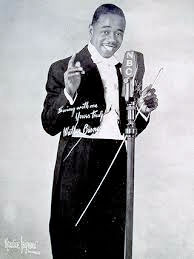Last Updated on September 4, 2013 by Honeyboy
Walter Barnes and the New Creolians were one of the big bands of the 1930’s. They were based in Chicago but regularly went on long tours of the south and traveled the clubs of the old Chitlin’ Circuit. In fact, you could say they helped build it.
Their current tour was almost over and they were ready to head home to Chicago, when they got one more gig in Natchez, Mississippi at The Rhythm Club.
The Rhythm Club was a former hardware store and Pentecostal church and was 150 feet by 60 feet and made from lumber and corrugated tin. It was located in the black part of town known as The Triangle. It was run by a group of friends called The Moneywasters Social Club. They were a group of a dozen or so buddies who liked to drink, gamble, and throw dances at this club.
They originally had booked Tiny Bradshaw to play on this night, April 23rd, 1940, but when Bradshaw got a better gig at Harlem’s Apollo Theatre, he cancelled on the Moneywasters. So to find a replacement, they contacted Walter Barnes through wife and manager, Dorothy Barnes, who had left the band’s tour early and was back in Chicago. They replaced Bradshaw with The New Creolians, who where about to head home to Chicago after their typical fall to spring tour down south.
Dorothy wired Walter… “One more gig.”
Who Was Walter Barnes and The New Creolians?
Walter Barnes was part musician and part entrepreneur. He knew how to promote himself, he knew how to dress, and he knew how to put on a show. He was a writer for the black newspaper, out of Chicago called The Defender. This paper was read throughout the country by the black population and had a lot of influence in the black community all over the south.
Barnes managed to keep the newspaper filled with his own stories and that of his band. He also knew enough to push other bands and promote the clubs he wanted to play. His band was often featured in the paper, along with many of the top swing bands of the day. That’s where the Moneywasters found The New Creolians and managed to book them at the last minute.

Bandleader Walter Barnes
Walter Barnes led the house band at Al Capone’s Cotton Club in Chicago and was good friends with the gangster. And through the 1930’s, the heyday of swing orchestras, he owned the airways and clubs, not only in Chicago, but throughout the “Chitlin’ Circuit” as it would be known. With the Depression in full swing, made it hard to get enough local work for a band to survive..
This touring concept was new. Most bands preferred to stay home and do long stints at one club. But the depression ended that, so bands were starting to hit the road. This was called Barnstorming and Walter Barnes practically invented it. And this was also the beginning of the Chitlin’ Circuit.
Like Barnes said in the Defender… “Bands, I mean big bands, are now taking to the road rather than hold one stand indefinitely. There’s more money on the road and in barnstorming, even in one-night jumps…”
And all the bands were doing it… even the elite bands like Duke Ellington and Louis Armstrong, who played mostly for white audiences.
But the southern black audiences were hungry for that music too. Walter Barnes was not quite in the same league musically or reputation wise as Ellington, but he could do a good enough imitation that he developed his own tour of “Cotton Clubs” and “Congo Rooms” throughout the south that were happy to book him and his band.
Now the swing scene was based on dancing. The band’s goal, as well as their promoters, were to get the dancers out. They played the music to do that and most joints were jumpin’ with Lindy Hoppers, Jitter Buggers, Fox Trotters and the many variations of each. And Walter Barnes kept up with the times and changed his band to fit tastes and learned the songs that kept people dancing and the band working.
He did this throughout the lean 30’s when many bands struggled. The New Creolians became The Kings of Swing, as they began to call themselves, worked regularly… down south in the winter, and up north in the summer.
The Rhythm Club Gets Hot
On this April 23 night in Natchez Mississippi, the party was about to begin. The Moneywasters had decked out the room in dried Spanish moss, spritzed with a little kerosene to keep the mosquitoes away, and had created a kind of gauntlet, with one way in and one way out. They boarded up the extra doors and windows so unwanted freeloaders couldn’t get in.
At 11:30 that night, Barnes called “Clarinet Lullaby” and settled in to jam. There was some scuffling at one end, which the band wrote off as just another fight breaking out. But when Barnes turned around he saw fire dance up the wall around the front door.
Now a little fire didn’t scare Walter none. He had seen it before. And in black communities, where open flames and stoves were the norm, they knew how to stay cool.
Barnes didn’t move… “You can all get out if you keep calm,” he called.
He faced the band and directed them to play “Marie,” a lilting Irving Berlin tune.
But drummer Oscar Brown was having none of it. He stood up and took the hammer he used to nail down his drum set and pounded his way out one of the boarded up windows.
Everyone else stayed and just played louder when the crowd began to scream. Barnes exhorted his band through the thickening smoke, “Play, play!”
Finally the tin roof collapsed and the walls came in, and the oxygen was gone. Flames took over the bandstand and the roof came down on them.
Two hundred and nine people died that night including 10 of the 12 band members. The fire would forever change how clubs would be built. At least after some time to reflect on what it all meant. The many firetraps throughout the south would eventually be different.
But for now it was just sadness around the Chitlin’ Circuit.
Many songs were written about that night, including “Mississippi Fire Blues,” and “Natchez Mississippi Blues,” and Howlin’ Wolf and John Lee Hooker wrote about the fire later. There was a book too.
But that night would be famous in the history of the Chitlin’ Circuit. And the lesson learned may only have been… choose your venues wisely… and make sure there’s a way out for the band.
Much of this story came from a great book called “The Chitlin’ Circuit and the Road to Rock and Roll.” lost of great stories like this in the book.


